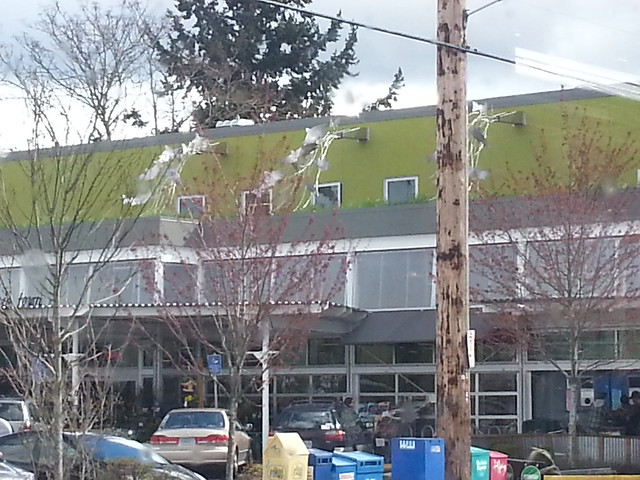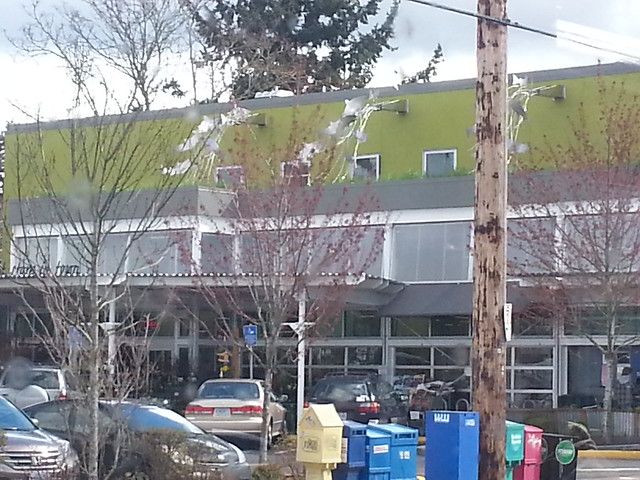View Larger Map
A few years ago, the city of Portland finally did something about the accident-prone intersection of East Burnside, Sandy Boulevard, and 12th Avenue, after a few decades of the public complaining about it. Not everyone loves the resulting Burnside-Couch couplet, but at least the one crazy intersection isn't so crazy anymore. The change involved closing the 2 block diagonal stretch of Sandy between 12th and 14th, as well as one block of NE 13th between Burnside and Couch. The resulting two-block area is supposed to be redeveloped someday, presumably into upscale condos or something. The couplet was the previous mayor's baby and the whole thing seems to have lost momentum after the last election. So for the most part the traffic flow shift is the only thing that's changed so far.
One thing they've managed to do here is jackhammer up part of the former 13th Avenue and turn it into a meandering bioswale, thanks to the city's ongoing obsession with stormwater management. At the Burnside end of the bioswale is a tall metal sculpture with a series of stainless steel fins projecting up from a concrete block. You may have guessed from the post title (and from the general artsy theme I've been running with lately) that this sculpture is why we're here. I noticed it when driving past on Burnside a while back, made a mental note of it, and later tried the usual sources to see what I could find out about it. Searching RACC, the Smithsonian art database, and the library's Oregonian database all came up with nothing. No news stories, no press releases from the city, nothing. When I went to take these photos, I looked all over for a sign giving a title, maybe an artist, something explaining what it's about. I couldn't find a sign, so no luck there either.
So after searching the entire internet, I've found precisely two city documents that mention it. Because we're a deeply process-oriented city, the city's Transportation Bureau had to get a permit from the Bureau of Development Services (a.k.a. the city planning department) before proceeding with the bioswale project. The first pdf (containing the city's official approval of the plan) includes a diagram that calls it Memorial Column, and credits it to Lloyd D. Lindley and Nevue Ngan Associates, while the second (the city's permit application) includes detailed schematics. I see that the sculpture was created by urban designers and landscape architects, so it looks like the local public art community wasn't involved here. Which I guess would explain why it's not in the RACC database. The approval doc explains that the bioswale might be only temporary, assuming the eventual swanky condo towers come with bioswales of their own, but the sculpture has to stay, regardless. The approval further explains "The tall vertical element reveals this important place from a few blocks away" and "As a memorial to a PBOT employee, the proposed column integrates Portland as a
theme". The phrasing there is because the city planners have to explain how the design furthers their design goals, and "integrating Portland as a theme" (whatever that means) is apparently one of those goals.
So that's all I know. There are some obvious open questions: Who is this a memorial to? And why? There's obviously more to the story, but for the life of me I can't seem to answer those questions. You'd think there would have been a press release, a dedication ceremony, maybe some news stories, adoring quotes by former PBOT coworkers praising the honoree perhaps. But I can't find any record of any of these things. That seems like an odd oversight, if it was an oversight. And if it wasn't an oversight, but an attempt to downplay the whole thing, that would raise additional questions. I have no idea. As always, if you happen to have the missing puzzle pieces in your possession, feel free to leave a comment below and help sort out the mystery. Thx. Mgmt.









